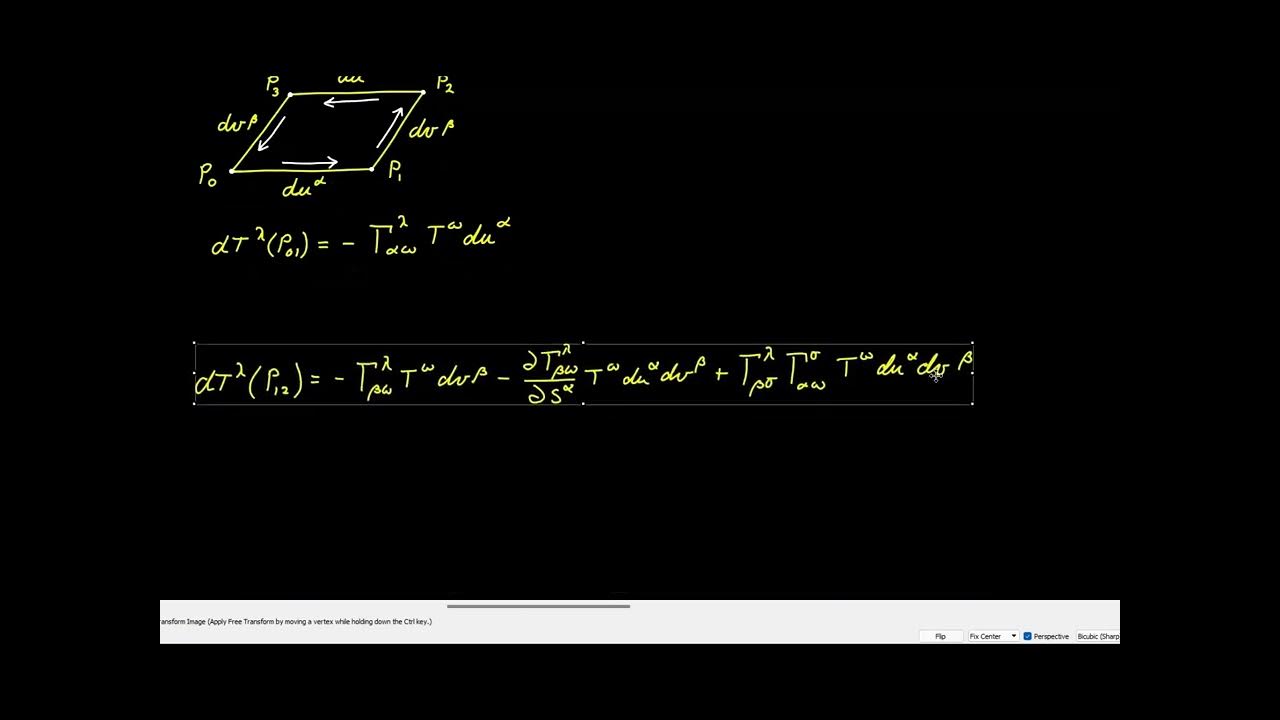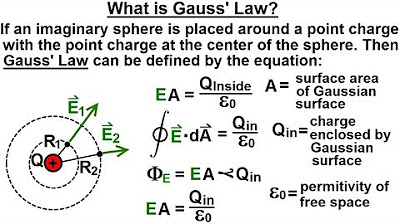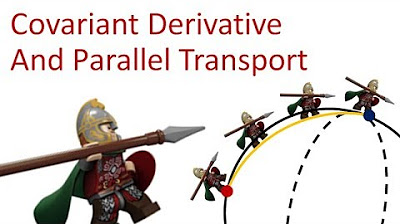Video 98 - Holonomy Part 1
TLDRThis video explores the concept of holonomy, demonstrating how the orientation of a vector changes when parallel transported around a closed loop on a curved surface like a sphere. It highlights the difference from flat surfaces and introduces the Gauss-Bonnet theorem, which quantifies the angle of rotation as a function of the surface's curvature and the area enclosed by the loop. The video also intriguingly notes that for a closed surface, the integral of the curvature over the entire surface equals 4π(1-g), where g is the genus, a constant value regardless of the surface's shape.
Takeaways
- 📚 The video introduces the concept of holonomy, which is the effect observed when a vector is parallel transported around a closed loop on a curved surface.
- 🌐 It demonstrates that on a spherical surface, parallel transporting a vector along different paths results in different final orientations, unlike on a flat plane.
- 🔄 The orientation of the vector after parallel transport on a curved surface depends on the chosen path, indicating there's no unique way to perform this operation.
- 🚫 Due to the dependence on the path, it's impossible to establish a constant vector field on a curved surface, as vectors at different points cannot be directly compared.
- 🔄 The video shows that when a vector is parallel transported around a complete loop on a sphere, it returns with a rotation, characterized by angle Phi.
- 📈 The Gauss-Bonnet theorem is presented as a method to quantify the angle of rotation (holonomy) caused by parallel transport on a curved surface.
- 🧮 The Gauss-Bonnet theorem involves an integral over the physical domain enclosed by the loop, with the curvature of the surface and the area element as key components.
- 🌍 For a sphere, the constant curvature allows simplification of the integral, resulting in the total angle of rotation being pi over 2 when transported around a quarter of the sphere.
- 🔢 The video provides a step-by-step example of applying the Gauss-Bonnet theorem to a circle embedded in a spherical surface, resulting in a specific angle of rotation.
- 🔍 The theorem is also shown to have a broader application when integrating over the entire closed surface, yielding a result related to the genus (number of holes) of the surface.
- 🕰 The Gauss-Bonnet theorem, proven by Gauss in 1827, is highlighted for its historical significance and its enduring relevance in understanding the properties of curved surfaces.
Q & A
What is the main topic discussed in this video?
-The main topic discussed in this video is holonomy, specifically its effects on parallel transporting a vector around a closed loop on a curved surface.
Why does the direction of a vector change when it is parallel transported on a spherical surface?
-The direction of a vector changes when parallel transported on a spherical surface due to the curvature of the surface. Unlike a flat surface, the orientation of the vector at the final point depends on the path chosen for the transport.
What is the significance of the angle Phi in the context of this video?
-In this video, the angle Phi represents the rotation angle that a vector undergoes after being parallel transported around a closed loop on a curved surface, which is an effect known as holonomy.
What is the Gauss-Bonnet theorem, and how does it relate to holonomy?
-The Gauss-Bonnet theorem is a mathematical theorem that quantifies the holonomy effect by stating that the angle of rotation (Phi) of a vector after parallel transport around a closed loop is equal to the integral of the product of the surface's curvature and the area element over the entire physical domain enclosed by the loop.
How does the curvature of a surface affect the outcome of parallel transporting a vector?
-The curvature of a surface determines the extent of rotation a vector will undergo when parallel transported. On a curved surface, such as a sphere, the vector will rotate, whereas on a flat surface, it would remain unchanged.
Why can't a constant vector field be established on a curved surface?
-A constant vector field cannot be established on a curved surface because it is impossible to compare vectors at different locations due to the varying orientations resulting from different paths of parallel transport.
What is the physical domain in the context of the Gauss-Bonnet theorem?
-The physical domain in the context of the Gauss-Bonnet theorem refers to the area enclosed by the loop over which the vector is parallel transported and around which the integral is evaluated.
What is the result of integrating the Gauss-Bonnet theorem over the entire closed surface of a sphere?
-When integrating the Gauss-Bonnet theorem over the entire closed surface of a sphere, the result is equal to 4π, as the genus of a sphere is zero, indicating no holes in the surface.
How does the genus of a surface affect the outcome of the Gauss-Bonnet theorem when integrated over the entire surface?
-The genus of a surface, which is the number of holes in the surface, affects the outcome of the Gauss-Bonnet theorem by being subtracted from 4π in the final expression. For example, a torus (with a genus of 1) would result in an integral value of zero.
What was the historical significance of the Gauss-Bonnet theorem when it was first proven?
-The Gauss-Bonnet theorem was proven by Carl Friedrich Gauss in 1827, which was a remarkable achievement in mathematics, especially considering it was 33 years before the American Civil War.
Outlines
🌐 Introduction to Holonomy and Parallel Transport
This paragraph introduces the concept of holonomy, which is the change in direction of a vector when it is parallel transported around a closed loop on a curved surface. The example of a spherical surface is used to illustrate how different paths of parallel transport can result in different final orientations for the same vector, highlighting the non-uniqueness of parallel transport on a curved surface compared to the fixed outcome on a flat surface. The inability to establish a constant vector field on a curved surface is also discussed, emphasizing the dependency of vector orientation on the chosen path.
📚 Gauss-Bonnet Theorem and Its Application
The Gauss-Bonnet theorem is introduced as a means to quantify the holonomy effect, where the rotation angle of a vector after parallel transport around a closed loop is equal to the integral of the product of the surface's Gaussian curvature and the area element over the enclosed physical domain. The constant curvature of a sphere simplifies the calculation, and an example calculation is provided to demonstrate how the theorem can be applied to find the rotation angle, resulting in a 90-degree rotation for a specific spherical loop. Another example involving a circle embedded in a spherical surface is also discussed, showing how the vector's rotation can be calculated using the theorem.
🔍 Detailed Analysis of the Gauss-Bonnet Theorem
This paragraph delves deeper into the Gauss-Bonnet theorem, providing a step-by-step breakdown of the double integral required to calculate the rotation angle for a vector transported around a circle on a spherical surface. The curvature of the sphere, the volume element, and the limits of integration are discussed. The calculation simplifies to an expression involving the cosine of the angle, which is then verified using the properties of the transported vector and the dot product of the initial and final vectors. The result confirms the accuracy of the Gauss-Bonnet theorem in this context.
🌍 Generalization of the Gauss-Bonnet Theorem for Closed Surfaces
The final paragraph generalizes the Gauss-Bonnet theorem for closed surfaces, explaining that the integral of the Gaussian curvature over the entire surface is equal to 4π times one minus the genus of the surface, where the genus is the number of holes in the surface. The theorem's remarkable feature is highlighted: regardless of the surface's shape or how it is twisted or stretched, the integral remains constant if the surface is continuous and unaltered. The historical context of Gauss's theorem, proven in 1827, is also mentioned, emphasizing the theorem's significance and longevity in the field of mathematics.
Mindmap
Keywords
💡Holonomy
💡Parallel Transport
💡Geodesic
💡Curvature
💡Gauss-Bonnet Theorem
💡Vector Field
💡Flat Surface
💡Surface Genus
💡Physical Integral
💡Topological Properties
Highlights
Introduction to the concept of holonomy, which is the effect observed when a vector is parallel transported around a closed loop on a surface.
Demonstration of parallel transport on a spherical surface, showing how the vector's direction changes depending on the path taken.
Explanation that on a curved surface, unlike a flat plane, the orientation of a parallel-transported vector is path-dependent.
Illustration that on a curved surface, it is not possible to establish a constant vector field due to the inability to compare vectors at different points.
Parallel transport of a vector around a closed loop on a sphere, resulting in a rotated vector indicating the phenomenon of holonomy.
Introduction of the Gauss-Bonnet theorem, which quantifies the holonomy effect through an integral involving the surface's curvature and the area element.
Application of the Gauss-Bonnet theorem to calculate the angle of rotation (Phi) for a vector transported around a closed loop on a sphere.
Calculation of the integral for a vector transported around a sphere, resulting in a 90-degree rotation, demonstrating the theorem's application.
Use of the Gauss-Bonnet theorem for a more complex configuration involving a circle embedded in a spherical surface.
Detailed explanation of the double integral process required for the Gauss-Bonnet theorem in two dimensions.
Verification of the theorem's result by calculating the dot product between the initial and final vectors after parallel transport.
Generalization of the Gauss-Bonnet theorem for integrating over the entire closed surface, relating the result to the surface's genus.
Remarkable feature of the Gauss-Bonnet theorem that the integral over a closed surface is always equal to 4π(1 - genus), irrespective of the surface's shape.
Historical context provided, noting that the Gauss-Bonnet theorem was proven by Gauss in 1827, 33 years before the American Civil War.
Brief review summarizing the video's content on holonomy, the Gauss-Bonnet theorem, and the implications for vector fields on curved surfaces.
Transcripts
Browse More Related Video

Video 99 - Holonomy Part 2

Physics 37.1 Gauss's Law Understood (3 of 29) What is Gauss' Law?

Video 81 - Intrinsic Curvature

Gauss law of electricity | Electrostatics | Physics | Khan Academy

Tensor Calculus Lecture 13b: Integration - The Divergence Theorem

Tensor Calculus 18: Covariant Derivative (extrinsic) and Parallel Transport
5.0 / 5 (0 votes)
Thanks for rating: